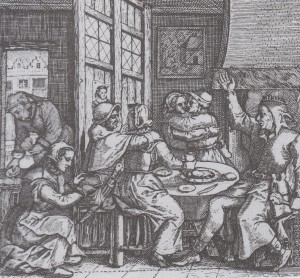By Joel Harrington (W&M Regular Contributor)
Rare is the human society, past or present, in which drinking alcohol has not served a variety of purposes. Naturally we think of relaxation and celebration, and of course the lubricating role of drink in a multitude of personal relationships: friendship, romance, business, politics, and even at the very end of life (think wakes).
In premodern Europe, drinking served all these functions and more. Beer and wine were ubiquitous, as were distilled spirits from the sixteenth century onward. Given the scarcity of potable water and other non-alcoholic drinks, personal consumption of a gallon a day of beer was not considered excessive. Even the smallest hamlet boasted at least a tavern or two. Not surprisingly, many if not most Europeans went through the day legally drunk by modern standards, providing some relief for the harsh conditions of their lives, but also spawning a growing problem with public drunkenness.
Alcohol also played a pivotal role in law enforcement. Or rather, in the most severe form of law enforcement—public executions. First, there were the condemned prisoners themselves, traditionally known as “the poor sinners.” In most locations, like today, the poor sinners were granted one last feast before the final hour. Some individuals had little appetite for any food, while others gorged themselves on meat and drink until the very last minute. Virtually every condemned soul was offered the executioner’s “special drink,” a high-alcohol concoction typically laced with a sedative. This was in fact a delicate operation, since some fragile women might pass out, while some boisterous young men might become even more aggressive, endangering the executioner and his assistants. The overarching goal was to calm an agitated poor sinner, but still make it possible for him or her to walk to the execution grounds from the prison and face death awake.
During the condemned prisoner’s procession to the gallows, alcohol played still another role—though hardly aiding the executioner in the performance of his duties. Spectators began assembling many hours before public executions, eager to secure good viewing spots. Street vendors selling bottles of beer and wine roamed the crowds, invariably populated to some degree by numerous drunken young men, jostling one another and singing ribald ditties. The poor sinner, public executioner, and other members of the formal death procession thus ran a gauntlet of shouting, spitting, and thrown objects on their way to the place of execution
Once having reached their destination, the executioner than often had to wait through long farewell speeches or sung ballads, often growing visibly more anxious. Drunken and angry spectators, after all, were known to verbally abuse the executioner as if he were a referee at a professional sports event—with the notable difference than any botched performance on his part might trigger a public stoning or other deadly assault on him and his assistants.
Not surprisingly, many professional executioners thus found solace in—what else—a drink. In fact, executioners were largely reputed to be heavy drinkers, even by premodern standards. While understandable, drinking too much before the execution sometimes caused mishaps, such as multiple strokes of the sword at a beheading. Crowds did not react well to botched executions, nor did government superiors, who fired without hesitation an executioner who ruined their public spectacles of justice. That is, if the crowd didn’t get to him first.
It was thus a remarkable anomaly when an executioner had a reputation as a sober man, yet the man I have come to know through the writing of my recent book—Meister Frantz Schmidt of Nuremberg—not only didn’t get drunk, he didn’t drink at all. This decision, as I discovered, was a very clever bit of self-promotion and marketing, but also reflected an exceptionally determined individual with a lifelong agenda.

